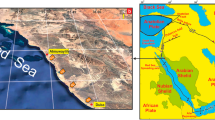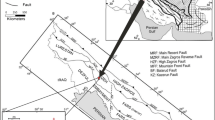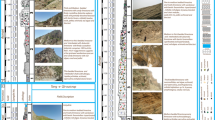Abstract
The upper successions of the raised reefal limestone of Jeddah coastal plain, especially at Obhur area, were investigated through three temporary exposed geologic sections such as south and northeast Obhur and Al Salam Street. Uranium-series age datings of these successions indicated that their topmost parts were mostly deposited during the last interglacial marine isotope stage 5e (MIS 5e). Lithological–faunal analyses and field observations allowed the division of these successions into two distinct layers: white limestone (lower) and brown shell-rich calcareous clay (upper). The lower layer is enriched with in situ coral boulders of Porites sp. and faviids, as well as with the foraminifers Amphistegina sp., indicating deposition near fore reef and reef crest environments. The upper layer is enriched with molluscs, echinoids, branched (and dwarfed faviids) corals, and the foraminifers Elphidium striatopunctatum and Challengerella bradyi, indicating deposition in back reef, lagoonal environments. The boundary between these two layers is very sharp and irregular, suggesting that the transition from the fore reef to lagoonal conditions was very rapid and catastrophe on coral reef ecosystem due likely to sea-level changes accompanied with warming and increased water runoff. The upper surface of the shell-rich calcareous layer seems to be truncated, but its microfossils could indicate that it was deposited when the sea level was higher than the present mean sea level (MSL) by at least 7 m.









Similar content being viewed by others
References
Abu-Zied RH, Bantan RA (2013) Hypersaline benthic foraminifera from the Shuaiba Lagoon, eastern Red Sea, Saudi Arabia: their environmental controls and usefulness in sea level reconstruction. Mar Micropaleontol 103:51–67
Abu-Zied RH, Keatings KW, Flower RJ (2007) Environmental controls on foraminifera in Lake Qarun Egypt. J Foraminifer Res 37:136–149
Abu-Zied RH, Bantan RA, El Mamoney MH (2011a) Present environmental status of the Shuaiba Lagoon, Red Sea coast, Saudi Arabia. JKAU Mar Sci 22:159–179
Abu-Zied RH, Bantan RA, Basaham AS, El Mamoney MH, Al-Washmi HA (2011b) Composition, distribution, and taphonomy of nearshore benthic foraminifera of the Farasan Islands, southern Red Sea, Saudi Arabia. J Foraminifer Res 41:349–362
Abu-Zied RH, Keatings K, Flower RJ, Leng M (2011c) Benthic foraminifera and their stable isotope composition in sediment cores from Lake Qarun, Egypt: changes in water salinity during the past ~500 years. J Paleolimnol 45:167–182
Abu-Zied RH, Basaham AS, El Sayed MA (2013) Effect of municipal wastewaters on bottom sediment geochemistry and benthic foraminifera of two Red Sea coastal inlets, Jeddah, Saudi Arabia. Environ Earth Sci 68:451–469
Ahmed F, Sultan SAR (1989) Surface heat fluxes and their comparison with the oceanic heat flux with Red Sea. Oceanol Acta 12:33–36
Al-Dubai TAM (2011) Environmental assessment of the southern Corniche of Jeddah using remote sensing, GIS and field study. Unpublished MSc thesis, King Abdulaziz University, 200 pp
Al-Sayari SS, Zötl JG (1978) Quaternary period in Saudi Arabia, vol I. Springer-Verlag, Wein, 335 pp
Al-Washmi HA (1999) Sedimentological aspects and environmental conditions recognized from the bottom sediments of Al-Kharrar Lagoon, eastern Red Sea coastal plain, Saudi Arabia. JKAU Mar Sci 10:71–87
Arz HW, Pätzold J, Müller PJ, Moammar MO (2003) Influence of Northern Hemisphere climate and global sea level rise on the restricted Red Sea marine environment during termination I. Paleoceanography 18:31-1–31-13
Bahafzallah AAK, El-Askary MA (1981) Sedimentological and micropaleontological investigations of the beach sands around Jeddah, Saudi Arabia. Bull Fac Earth Sci KAU 4:25–42
Bantan RA (2006) Morphological features and sedimentological aspects of Wadi Al-Kura, north of Jeddah, western coast of Saudi Arabia. JKAU Mar Sci 17:153–165
Bantan RA, Abu-Zied RH (2014) Sediments characteristics and molluscan fossils of the Farasan Islands shorelines, southern Red Sea, Saudi Arabia. Arab J Geosci 7(2):773–787
Basaham AS (2004) Diagenetic processes and the paleo-climate of the Quaternary raised coral reef terraces, Red Sea coast of Saudi Arabia. J Man Environ Sci 28:163–189
Basaham AS (2008) Mineralogical and chemical composition of the mud fraction from the surface sediments of Sharm Al-Kharrar, a Red Sea coastal lagoon. Oceanologia 50(4):557–575
Behairy AKA (1983) Marine transgressions in the west coast of Saudi Arabia between mid-Pleistocene and present. Mar Geol 52:M25–M31
Behairy AKA, Meshal AK, Osman MM (1981) Evaporation from the central zone of the Red Sea. Jed J Mar Res 1:21–28
Behairy AKA, Durgaprasada Rao NVN, Abou-Ouf M, El-Abed YI, El-Ghobary H (1987) Depositional and diagenetic history of evaporitic sediments in a coastal lagoon and sabkha, eastern Red Sea. Res Proj 145/407, Fin Rep Fac Mar Sci, Jeddah, Saudi Arabia
Berner RA (1994) Geocard II: a revised model for atmospheric CO2 over Phanerozoic time. Am J Sci 294:56–91
Cimerman F, Langer MR (1991) Mediterranean foraminifera. Slovenian Academy of Science and Arts and Swiss Academy of Natural Sciences, Ljubljana, 118 pp
Dawood YH, Aref MA, Mandurah MH, Hakami A, Gameil M (2013) Isotope geochemistry of the Miocene and Quaternary carbonate rocks in Rabigh area, Red Sea coast, Saudi Arabia. J Asian Earth Sci 77:151–162
Debenay J-P, Tsakiridis E, Soulard R, Grossel H (2001) Factors determining the distribution of foraminiferal assemblages in Port Joinville Harbor (Ile d’Yeu, France): the influence of pollution. Mar Micropaleontol 43:75–118
Dullo WC (1990) Facies, fossil record, and age of Pleistocene reefs from the Red Sea (Saudi Arabia). Facies 22:1–45
Durgaprasada Rao NVN, AL-Imam OAO, Behairy AKA (1987) Early mixed-water dolomitization in the Pleistocene reef limestones, west coast of Saudi Arabia. Sediment Geol 53:231–245
Dutton A, Lambeck K (2012) Ice volume and sea level during the last interglacial. Science 337:216–219
Edwards FJ (1987) Climate and oceanography. In: Edwards AJ, Head SM (eds) Key environments Red Sea, 1st edn. Pergamon, Oxford, pp 45–68
El Sabrouti MA (1983) Texture and mineralogy of the surface sediments of Sharm Obhur, west Red Sea coast of Saudi Arabia. Mar Geol 53:103–116
Fairbanks RC (1989) A 17,000 year glacio-eustatic sea level record: influence of glacial melting rates on the Younger Dryas event and deep-ocean circulation. Nature 342:637–642
Gheith AM, Abou Ouf MA (1994) Textural characteristics, mineralogy and fauna in the shore zone sediments at Rabigh and Sharm al-Kharrar, Eastern Red Sea, Saudi Arabia. J KAU Mar Sci 7:107–131
Gvirtzman G, Buchbinder B (1978) The late Tertiary of the coastal plain and continental shelf of Israel and its bearing on the history of the eastern Mediterranean. Initial Rep Deep Sea Drill Proj 42:1195–1222
Haig DW (1988) Miliolid foraminifera from inner neritic and mud facies of the Papuan Lagoon. J Foraminifer Res 18:203–236
Hallock P (1999) Symbiont-bearing foraminifera. In: Sen Gupta BK (ed) Modern foraminifera. Kluwer, Dordrecht, pp 123–139
Hallock P (2001) Global change and modern coral reefs: new opportunities to understand shallow-water carbonate depositional processes. Sediment Geol 175:19–33
Haunold TG, Baal C, Piller WE (1997) Benthic foraminiferal associations in the northern Bay of Safaga, Red Sea, Egypt. Mar Micropaleontol 29:185–210
Hearty PJ (2002) A revision of the Late Pleistocene stratigraphy of Bermuda. Sediment Geol 153:1–21
Hearty PJ, Neumann AC (2001) Rapid sea level and climate change at the close of the last interglaciation (MIS 5e): evidence from the Bahamas Islands. Quat Sci Rev 20:1881–1895
Hearty PJ, Neumann AC, Hollin JT, O’Leary MJ, McCulloch MT (2007) Global sea level fluctuations during the last interglaciation (MIS 5e). Quat Sci Rev 26:2090–2112
Hemleben C, Meischner D, Zahn R, Almogi-Labin A, Erlenkeuser H, Hiller B (1996) Three hundred eighty thousand year long stable isotope and faunal records from the Red Sea: influence of global sea level change on hydrography. Paleoceanography 11:147–156
Hiscock K (1983) Water movement. In: Earll R, Erwin DG (eds) Sublittoral ecology: the ecology of the shallow sublittoral benthos. Clarendon, Oxford, pp 58–96
Hoang CT, Taviani M (1991) Stratigraphic and tectonic implications of uranium-series dated coral reefs from uplifted Red Sea islands. Quat Res 35:264–273
Hohenegger J (1994) Distribution of living larger foraminifera NW of Sesoko-Jima, Okinawa Japan: PSZN I. Mar Ecol 15:291–334
Hohenegger J (2004) Depth coenoclines and environmental considerations of western Pacific larger foraminifera. J Foraminifer Res 34:9–33
Hottinger L, Halicz E, Reiss Z (1993) Recent foraminiferida, Gulf of Aqaba, Red Sea. Opera Academia Scientiarum et Artium Slovenica, Classis IV: Historia Naturalis, 33; Paleontological Institute “Ivan Rakovec”, 3
Jado AR, Zötl JG (1984) Quaternary period in Saudi Arabia, vol 2. Springer, Heidelberg
Jones RW (1994) The challenger foraminifera. Oxford University Press, Oxford
Kuhnt T, Schmiedl G, Ehrmann W, Hamann Y, Hemleben C (2007) Deep-sea ecosystem variability of the Aegean Sea during the past 22 kyr as revealed by benthic foraminifera. Mar Micropaleontol 64:141–162
Lambeck K, Purcell A, Dutton A (2012) The anatomy of interglacial sea levels: the relationship between sea levels and ice volumes during the Last Interglacial. Earth Planet Sci Lett 315–316:4–11
Lobegeier MK (2002) Benthic foraminifera of the family Calcarinidae from Green Island Reef, Great Barrier Reef Province. J Foraminifer Res 32:201–216
Loeblich AR, Tappan H (1987) Foraminiferal genera and their classification, vol 2. Van Nostrand Reinhold, New York
Manaa A (2011) Late Pleistocene raised coral reefs in the eastern Red Sea—Rabigh, Saudi Arabia. Master of Science Research thesis, School of Earth and Environmental Sciences, University of Wollongong. http://ro.uow.edu.au/theses/3501
Mandurah MH, Aref MAM (2012) Lithostratigraphy and standard microfacies types of the Neogene carbonates of Rabigh and Ubhur areas, Red Sea coastal plain of Saudi Arabia. Arab J Geosci 5:1317–1332
Morcos SA (1970) Physical and chemical oceanography of the Red Sea. In: Barnes M (ed) Oceanography and marine biology, vol 8. G. Allen, London, pp 73–202
Nesteroff WD (1959) Age des derniers mouvements du graben de la Mer Rouge déterminé par la méthode du C14 appliquée aux récifs fossiles (Age of the last movements of the Red Sea graben determined by the carbon-14 method applied to fossil reefs). Soc Géol France Bull, ser 7, 1:415–418
O’Leary MJ, Hearty PJ, McCulloch MT (2008) Geomorphic evidence of major sea-level fluctuations during marine isotope substage-5e, Cape Cuvier, Western Australia. Geomorphology 102:595–602
O’Leary MJ, Hearty PJ, Thompson WG, Raymo ME, Mitrovica JX, Webster JM (2013) Ice sheet collapse following a prolonged period of stable sea level during the last interglacial. Nat Geosci 6:796–800
Parker JH, Gischler E, Eisenhauer A (2012) Biodiversity of foraminifera from Late Pleistocene to Holocene coral reefs, South Sinai, Egypt. Mar Micropaleontol 86–87:59–75
Patzert WC (1974) Wind-induced reversal in the Red Sea circulation. Deep-Sea Res 21:109–121
Plaziat J-C, Reyss J-L, Choukri A, Cazala C (2008) Diagenetic rejuvenation of raised coral reefs and precision of dating. The contribution of the Red Sea reefs to the question of reliability of the uranium-series datings of Middle to Late Pleistocene key reef-terraces of the world. Carnets Géol 4:1–35
Reiss Z, Hottinger L (1984) The Gulf of Aqaba, ecological micropaleontology: ecological studies, vol 50. Springer Verlag, Berlin, pp 1–354
Riedl R (1964) Die Erscheinungen der Wasserbewegung und ihre Wirkung auf Sedentarier im mediterranen Felslitoral. Helgoländer wissenschaftliche Meeresuntersuchungen, vol 10, pp 155–186
Rohling EJ (1994) Glacial conditions in the Red Sea. Paleoceanography 9:653–660
Rohling EJ, Fenton M, Jorissen FJ, Bertrand P, Gansen G, Caulet JP (1998) Magnitudes of sea level lowstands of the past 500,000 years. Nature 394:162–165
Rohling EJ, Grant K, Hemleben C, Siddall M, Hoogakker BAA, Bolshaw M, Kucera M (2008) High rates of sea-level rise during the last interglacial period. Nat Geosci 1:38–42
Sestini J (1965) Cenozoic stratigraphy and depositional history, Red Sea coast, Sudan. Am Assoc Petrol Geol Bull Tulsa 49:1452–1472
Sgarrella F, Moncharmont-Zei M (1993) Benthic foraminifera of the Gulf of Naples (Italy): systematic and autoecology. Boll Soc Paleontol Ital 32:145–264
Sheppard CRC, Price ARG, Roberts CM (1992) Marine ecology of the Arabian region: patterns and processes in extreme tropical environments. Academic, London
Skipwith P (1973) The Red Sea and coastal plain of the Kingdom of Saudi Arabia. Saudi Arabian Directorate General of Mineral Resources, Technical Record TR-1973-1, p 149
Sneh A, Friedman GM (1980) Spur-and-groove patterns on the reefs of the northern gulfs of the Red Sea. J Sediment Petrol 50:981–986
Tomascik T, Sander F (1987) Effects of eutrophication on reef-building corals: II. Structure of scleractinian coral communities on fringing reefs, Barbados, West Indies. Mar Biol 94:53–75
Vincent P (2008) Saudi Arabia: an environmental overview. Taylor & Francis, London, 332 pp
Yassini I, Jones BG (1995) Recent foraminifera and ostracoda from estuarine and shelf environments on the southeastern coast of Australia. University of Wollongong Press, Wollongong
Acknowledgments
This paper was funded by the Deanship of Scientific Research (DSR), King Abdulaziz University, Jeddah, under grant no. 276/150/1433. The authors, therefore, acknowledge with thanks the DSR technical and financial support. We thank both reviewers for their constructive comments and spending their time to improve the manuscript. Special thanks to Anton Eisenhauer for helping in the U/Th-series age dating of the studied sediment samples.
Author information
Authors and Affiliations
Corresponding author
Rights and permissions
About this article
Cite this article
Bantan, R.A., Abu-Zied, R.H. & Haredy, R.A. Lithology, fauna and environmental conditions of the Late Pleistocene raised reefal limestone of the Jeddah coastal plain, Saudi Arabia. Arab J Geosci 8, 9887–9904 (2015). https://doi.org/10.1007/s12517-015-1884-6
Received:
Accepted:
Published:
Issue Date:
DOI: https://doi.org/10.1007/s12517-015-1884-6




